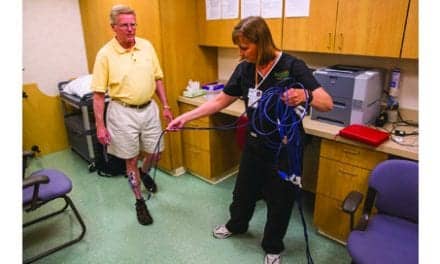Research presented recently at the Society of Interventional Radiology’s 2018 Annual Scientific Meeting suggests the possibility that a minimally invasive treatment involving a pinhole incision in the knee could help reduce the inflammation and pain associated with osteoarthritis.
The image-guided treatment, called geniculate artery embolization (GAE), blocks key arteries in the knee to reduce inflammation and pain.
According to results from a US clinical trial of the treatment, a majority of study participants achieved significant pain reduction and improvements in range of motion, avoiding more invasive measures, notes the Society of Interventional Radiology in a media release.
“A majority of our patients with osteoarthritis of the knee saw significant pain reduction, not only just a few days after the procedure, but a month after as well, making this an accessible treatment for patients looking to improve their quality of life without surgery,” says Sandeep Bagla, MD, director of interventional radiology at the Vascular Institute of Virginia and lead author of the study.
“We are very encouraged by the results and the implications for the millions suffering from this common, yet debilitating condition.”
Interventional radiologists perform GAE for knee pain by inserting catheters through a pinhole-sized incision, blocking the very small arteries or capillaries within the lining of the knee, reducing the inflammation caused by osteoarthritis. As an outpatient treatment, GAE does not require open surgery or physical therapy, and takes 45 to 90 minutes to perform.
The prospective, multicenter clinical trial evaluated 13 patients with severe osteoarthritis pain. Each patient’s pain and disability were measured along two scales, with evaluations before and after the treatment. The treatment was successfully completed in all 13 patients, with no adverse events. One month later, researchers followed the progress of eight patients and found that GAE significantly decreased pain (-58 mm on the Visual Analog Scale), reduced stiffness, and increased physical function (-36.3 on the Western Ontario and McMaster University Osteoarthritis Index). Together the scales represent an 80% improvement in function compared with pre-procedure conditions, the release explains.
“This procedure could have a significant impact in the treatment of osteoarthritis pain as a whole,” Bagla adds. “The current mainstay of treatment in patients who have arthritis are pain medications, which come with significant side effects and risks. But GAE provides another option for patients struggling with pain and may even allow patients to avoid the painful recovery of knee surgery and the need for the kind of opioid pain medications associated with the dangerous epidemic in the United States.”
This study builds on the growing international research around GAE and osteoarthritis. While preliminary data shows that the treatment does work and is feasible, it has only been used in a clinical trial setting. The study has completed enrollment of 20 patients and final results are expected in summer 2018. A second randomized controlled clinical trial began in February 2018 and will provide further data on what types of patients are the best candidates for this treatment and how it could move toward clinical practice, per the release.
[Source: Society of Interventional Radiology]





